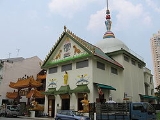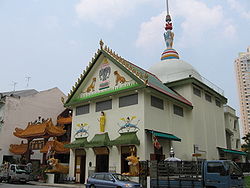
Sakya Muni Buddha Gaya Temple
Encyclopedia

Buddhism
Buddhism is a religion and philosophy encompassing a variety of traditions, beliefs and practices, largely based on teachings attributed to Siddhartha Gautama, commonly known as the Buddha . The Buddha lived and taught in the northeastern Indian subcontinent some time between the 6th and 4th...
temples in Singapore
Singapore
Singapore , officially the Republic of Singapore, is a Southeast Asian city-state off the southern tip of the Malay Peninsula, north of the equator. An island country made up of 63 islands, it is separated from Malaysia by the Straits of Johor to its north and from Indonesia's Riau Islands by the...
, often referred to as the Temple of 1,000 Lights. It features a 15-meter high statue of a seated Buddha
Buddharupa
Buddharūpa is the Sanskrit and Pali term used in Buddhism for statues or models of the Buddha.-Commonalities:...
, which weighs nearly 300 tons, as well as many smaller Buddha image
Buddharupa
Buddharūpa is the Sanskrit and Pali term used in Buddhism for statues or models of the Buddha.-Commonalities:...
s and mural
Mural
A mural is any piece of artwork painted or applied directly on a wall, ceiling or other large permanent surface. A particularly distinguishing characteristic of mural painting is that the architectural elements of the given space are harmoniously incorporated into the picture.-History:Murals of...
s depicting the life of Shakyamuni Buddha. The large central statue is surrounded by a stylized aura made of numerous light bulbs--often lit during evening hours--from which the temple derives its nickname. In a small room beneath the altar is an image of a reclining Buddha, Buddha towards the end of his life, under a Yellow Seraka Tree.
The Sakya Muni Buddha Gaya Temple was founded in 1927 by a Thai monk called Vutthisara
On Vesak
Vesak
Vesākha is a holiday observed traditionally by Buddhists in Bangladesh, India, Nepal, Sri Lanka, and the South East Asian countries of Singapore, Vietnam, Thailand, Cambodia, Laos, Malaysia, Burma, and Indonesia...
Day, the annual holiday celebrating the birth and enlightenment
Bodhi
Bodhi is both a Pāli and Sanskrit word traditionally translated into English with the word "enlightenment", but which means awakened. In Buddhism it is the knowledge possessed by a Buddha into the nature of things...
of the Buddha, devotees donate money to the temple and in exchange are allowed to place gold
Gold
Gold is a chemical element with the symbol Au and an atomic number of 79. Gold is a dense, soft, shiny, malleable and ductile metal. Pure gold has a bright yellow color and luster traditionally considered attractive, which it maintains without oxidizing in air or water. Chemically, gold is a...
leaf onto a small statue of the Buddha. As the day wears on, the Buddha is almost entirely covered in a fresh layer of gold leaf.
There are strong Thai influences in the architecture and decor.
The temple is open between 8.00 am and 4.45 pm daily. Admission is free.

